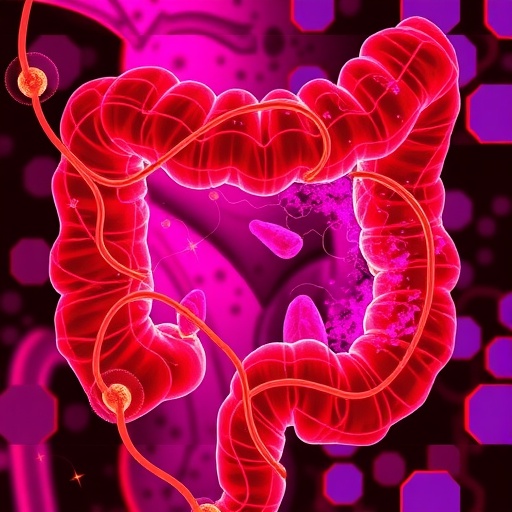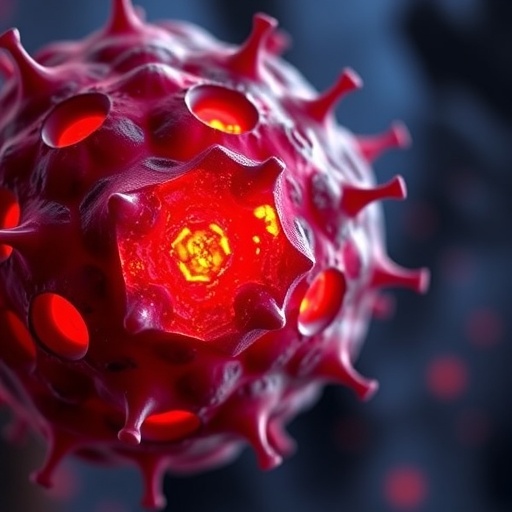Colorectal cancer (CRC) stands as a formidable challenge in modern oncology, ranking third in global incidence and second in cancer-related mortality according to the latest comprehensive statistics from 2022. The disease’s propensity to progress to metastatic stages in approximately half of diagnosed patients underlines its aggressive nature and the pressing need for better therapeutic strategies. Beyond its clinical burden, CRC imposes profound economic and societal costs worldwide, spurring intense research into its complex biological underpinnings.
At the cellular level, organelles typify the intricate machinery sustaining life, but they are also key players in the onset and progression of malignancies. Among these, mitochondria have emerged as central to cancer biology, with dysfunctions linked not only to metabolic aberrations but also developmental disorders and neurodegenerative diseases. Similarly, the endoplasmic reticulum (ER) operates as a pivotal hub, whose perturbation triggers ER stress and an unfolded protein response (UPR). This response has been implicated across a spectrum of diseases, notably including cancer, where it influences tumor growth dynamics and resistance to conventional chemotherapies.
Recent insights underscore the intimate communication between mitochondria and the ER, mediated predominantly through mitochondria-associated ER membranes (MAMs). This inter-organelle crosstalk is fundamental for cellular homeostasis and is critically implicated in tumorigenesis within CRC. MAMs serve as a nexus where calcium homeostasis, lipid metabolism, mitochondrial dynamics, and ER stress responses converge, collectively influencing cancer cell survival, proliferation, and invasion.
At a molecular level, the mitochondrion is a highly compartmentalized organelle featuring an outer mitochondrial membrane rich with proteins such as the voltage-dependent anion channel (VDAC) and mitochondrial fusion protein 2 (MFN2), which orchestrate calcium flux and mitochondrial morphology. The inner mitochondrial membrane houses the mitochondrial calcium uniporter (MCU), channeling calcium into the matrix, a site that hosts the tricarboxylic acid cycle and mitochondrial DNA replication. Crucially, the mitochondrial cristae accommodate the oxidative phosphorylation machinery, responsible for adenosine triphosphate (ATP) synthesis and paradoxically generating reactive oxygen species (ROS), which can drive oncogenic pathways.
On the other side, the ER manifests in two principal structural states: the ribosome-studded rough ER, which facilitates protein synthesis, and the smooth ER, which governs lipid metabolism and calcium storage. The ER’s role in maintaining cellular proteostasis becomes perturbed under stress, initiating the UPR. Dysregulation of this response contributes to tumor progression and chemoresistance, highlighting the ER’s dual role as both a survivor and executioner depending on cellular context.
Mitochondria-associated ER membranes represent specialized subdomains where the membranes of these two organelles juxtapose to enable direct biochemical exchange. MAMs regulate a gamut of cellular processes by facilitating the transfer of calcium ions, lipids, and metabolites. In CRC, aberrations in MAMs modulate calcium signaling pathways via altered expression of channels and transporters such as SERCA, IP3R, VDAC, and MCU. These perturbations destabilize calcium homeostasis, critically tipping the balance between cell survival and apoptosis, and facilitating malignant transformation and resistance to therapy.
The lipidomics of MAMs paint another layer of complexity. Proteins like ANKRD22, TRIAP1, and ACSL4 modify lipid composition within mitochondria and ER in tumor cells, reshaping mitochondrial bioenergetics. This reprogramming not only influences the metabolic plasticity of CRC cells but also affects their responsiveness to chemotherapeutic agents. Targeting these lipid metabolic pathways within MAMs holds promise for novel, more effective interventions.
Mitochondrial dynamics—a balance between fission and fusion—intersect with autophagic processes in ways that decisively influence cancer progression. MAMs act as critical hubs modulating these dynamics; enhancing mitochondrial fusion while inhibiting fission and mitophagy may counteract drug resistance commonly seen in CRC. Natural compounds such as aloe gel glucomannan, tanshinone IIA, cirsiliol, and δ-valerobetaine have demonstrated efficacy in suppressing mitophagy, thereby enhancing treatment outcomes.
Moreover, the interaction between MAM components and the unfolded protein response reveals a sophisticated network where proteins like ATAD3A and PGC-1α temper ER stress and mediate resistance to chemotherapeutics such as 5-fluorouracil in CRC cells. Intriguingly, a series of natural compounds—including trihydroxyurs-12-en-28-oic acid (TEOA), oleander leaf phenol extract (PEOL), jolkinolide B, and allyl isothiocyanate (AITC)—have been shown to induce apoptosis via ER stress, representing an innovative therapeutic direction.
This emerging landscape positions MAMs not merely as passive communication points but as dynamic regulators of cancer cell fate and drug responsiveness. The nuanced crosstalk between mitochondrial and ER networks orchestrated at MAMs advances our understanding of CRC biology and opens avenues for targeted therapies that exploit these inter-organelle interactions.
In summation, the intricate dialogue between mitochondria, ER, and their associated membranes drives key oncogenic processes in colorectal cancer. By elucidating the molecular choreography within MAMs, this compelling body of research illuminates novel targets for therapeutic intervention, promising improved outcomes for CRC patients. Continued exploration of this frontier holds potential not only in cancer but broadly across diseases where organelle interplay dictates cellular destiny.
Genes & Diseases continues to contribute importantly to this expanding field by publishing rigorous, mechanism-driven research that bridges fundamental molecular biology with translational insights. As the quest to demystify CRC’s complexity intensifies, the focus on mitochondria-ER crosstalk and MAM functionality promises transformative discoveries and clinical breakthroughs in the near future.
Subject of Research: Crosstalk between mitochondria and endoplasmic reticulum via mitochondria-associated membranes (MAMs) in colorectal cancer tumorigenesis and therapy.
Article Title: [Not provided in the source content]
News Publication Date: [Not specified]
Web References:
Genes & Diseases: https://www.sciencedirect.com/journal/genes-and-diseases
DOI: http://dx.doi.org/10.1016/j.gendis.2025.101766
References: [Details not included]
Image Credits: Lanshu Xiao, Yao Wei, Yiping Qin, Bianqin Guo
Keywords: Mitochondria, Colorectal cancer
Tags: cancer biology and organelle functioncancer incidence and mortality statisticscellular homeostasis in tumorigenesiscolorectal cancer progression mechanismseconomic impact of colorectal cancerER stress and cancer treatment resistancemetabolic dysfunction in cancermitochondria and endoplasmic reticulum interactionmitochondria-associated ER membranes roleoncological research and organelle dynamicstherapeutic strategies for colorectal cancertumor microenvironment and organelle communication





